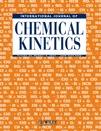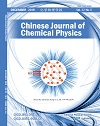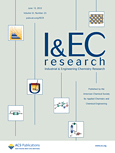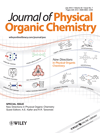
INTERNATIONAL JOURNAL OF CHEMICAL KINETICS
Scope & Guideline
Advancing the frontiers of chemical dynamics.
Introduction
Aims and Scopes
- Chemical Reaction Kinetics:
Exploration of the rates of chemical reactions, including the development of mathematical models to describe the kinetics of various processes. - Mechanistic Studies:
In-depth analyses of reaction mechanisms, focusing on the pathways and intermediates involved in chemical transformations. - Theoretical and Computational Approaches:
Utilization of computational methods and theoretical frameworks to predict reaction kinetics and mechanisms, including ab initio calculations and molecular dynamics simulations. - Environmental and Industrial Applications:
Investigation of kinetic processes relevant to environmental chemistry and industrial applications, such as pollutant degradation, catalysis, and energy production. - Advanced Experimental Techniques:
Application of innovative experimental methods to measure reaction rates and reveal kinetic parameters, including shock tube experiments and spectroscopic techniques.
Trending and Emerging
- Machine Learning and AI in Kinetics:
An increasing number of publications are exploring the application of machine learning and artificial intelligence to predict reaction kinetics and optimize experimental design, reflecting the journal's engagement with cutting-edge technology. - Green Chemistry and Sustainable Practices:
Research focusing on environmentally friendly processes, including the use of renewable resources and sustainable catalysts, is on the rise. This trend highlights the journal's commitment to addressing global environmental challenges. - Complex Reaction Networks:
There is a growing interest in investigating complex reaction networks and their kinetics, moving beyond simple reaction models to explore interconnected systems that better represent real-world chemical processes. - Interdisciplinary Approaches:
Emerging studies are increasingly drawing from interdisciplinary fields, such as materials science and biochemistry, to enhance the understanding of chemical kinetics, indicating a trend towards collaborative research that bridges traditional boundaries. - Real-Time Kinetic Monitoring:
Advancements in real-time monitoring techniques are gaining traction, allowing for the observation of reaction kinetics as they occur, thus providing richer datasets for analysis and interpretation.
Declining or Waning
- Traditional Kinetic Studies:
There seems to be a decline in studies focusing solely on traditional kinetic experiments without the incorporation of advanced computational or theoretical analyses. This reflects a shift towards more integrated approaches that combine theory and experiment. - Isolated Reaction Studies:
Research focusing on isolated reactions with limited applicability to broader mechanistic understanding appears to be waning. The trend is shifting towards studies that connect multiple reactions or provide insights into complex reaction networks. - Applications of Older Experimental Techniques:
There is a noticeable decrease in the use of older experimental techniques that do not leverage modern advancements in measurement technologies, indicating a preference for more sophisticated and precise methodologies.
Similar Journals

CHINESE JOURNAL OF CHEMICAL PHYSICS
Exploring the Dynamic Landscape of Chemical PhysicsChinese Journal of Chemical Physics, published by the Chinese Physical Society, serves as a pivotal platform for advancing the field of chemical physics, encompassing groundbreaking research and innovative methodologies since its inception in 2000. With an ISSN of 1674-0068 and E-ISSN of 2327-2244, the journal has established itself within the academic community, reflected in its 2023 classification as Q3 in Physical and Theoretical Chemistry and a Scopus rank of #142 out of 189, representing the 25th percentile in this competitive field. Although it does not currently operate as an open-access publication, its commitment to disseminating pivotal scientific research continues to attract scholars and professionals alike. The journal aims to bridge the gap between theoretical principles and practical applications in chemical physics, thereby fostering collaboration and innovation. By contributing significantly to the discourse in this dynamic domain, the Chinese Journal of Chemical Physics remains an essential resource for researchers, professionals, and students eager to stay abreast of contemporary developments.

INDUSTRIAL & ENGINEERING CHEMISTRY RESEARCH
Transforming Ideas into Engineering ExcellenceINDUSTRIAL & ENGINEERING CHEMISTRY RESEARCH, published by the American Chemical Society, is a pivotal journal that disseminates high-quality research in the fields of Chemical Engineering, Chemistry, and Industrial and Manufacturing Engineering. With an impressive impact factor, this journal ranks in the top quartile (Q1) across multiple categories, reflecting its significance and influence within the scientific community. Since its inception in 1987, IECR has provided a platform for researchers, professionals, and students to publish innovative findings that advance the understanding and application of engineering chemistry. Though it operates under a subscription model, the journal continues to foster collaboration within the field, inviting contributions that span theoretical advancements, experimental studies, and practical applications. Whether you are engaged in academia or industry, IECR serves as a vital resource for staying abreast of the latest developments in chemical and engineering research.

JOURNAL OF PHYSICAL ORGANIC CHEMISTRY
Fostering collaboration in organic and physical sciences.JOURNAL OF PHYSICAL ORGANIC CHEMISTRY, published by Wiley, serves as a vital platform for researchers and professionals in the fields of organic and physical theoretical chemistry. With a rich history of publication dating back to 1988 and continuing through 2024, this esteemed journal aims to advance the understanding of the physical principles underlying organic reactions and processes. Although it operates without an open access model, the journal maintains a respectable impact factor and has achieved Q3 rankings in both Organic Chemistry and Physical and Theoretical Chemistry as of 2023, affirming its relevance within the scientific community. Researchers looking to publish innovative studies will find a competitive space given its Scopus rankings—placed at #105 in Physical and Theoretical Chemistry and #123 in Organic Chemistry. The journal not only curates high-quality research but also encourages collaboration and the exchange of ideas, making it a cornerstone for anyone dedicated to exploring the complexities of organic materials and their physical interactions.

Reactions
Exploring the Frontiers of Chemical InnovationReactions is a dynamic open-access journal published by MDPI, dedicated to the advancement of research in the fields of Chemical Engineering and Chemistry. Launched in 2020, the journal aims to provide a platform for scientists and researchers to share their findings and innovations, facilitating the synthesis and dissemination of knowledge within the global academic community. With an impact factor that reflects its growing influence, Reactions ranks 47th in the Chemical Engineering category and 72nd in Chemistry on Scopus, placing it within the vibrant landscape of contemporary chemical research. Housed in the picturesque city of Basel, Switzerland, the journal is committed to open access, ensuring that its high-quality content is readily available to all. This commitment not only enhances visibility but also fosters collaboration among researchers, professionals, and students striving to push the boundaries of chemical sciences. As we look towards 2024 and beyond, Reactions continues to encourage submissions that explore groundbreaking methodologies, innovative applications, and transformative theoretical frameworks in chemistry and chemical engineering.

CHEMICAL PHYSICS LETTERS
Fostering Collaboration in the World of Chemical PhysicsCHEMICAL PHYSICS LETTERS, published by Elsevier, is a prestigious journal that has been at the forefront of advancing knowledge in the fields of physical and theoretical chemistry and physics since its inception in 1967. With an impressive impact factor reflective of its high-quality research output, this journal holds Q2 quartile rankings in both the Physical and Theoretical Chemistry and Physics and Astronomy categories for 2023. It is recognized as a key platform for disseminating groundbreaking findings, with Scopus rankings placing it within the top 76th and 66th percentiles in its respective categories. Researchers and professionals benefit from its insightful contributions and rigorous peer-review process, making it an essential resource for those engaged in cutting-edge chemical physics studies. Although the journal is not open access, it remains accessible through various institutional subscriptions, ensuring that a wide audience can explore its wealth of knowledge. Located in Amsterdam, Netherlands, the journal continues to drive innovation and collaboration across diverse scientific disciplines.

TRANSACTIONS OF TIANJIN UNIVERSITY
Empowering knowledge exchange across diverse disciplines.TRANSACTIONS OF TIANJIN UNIVERSITY, published by SpringerNature, is a premier journal in the field of multidisciplinary research, boasting an impressive Q1 ranking and placing within the top 93rd percentile of its category according to Scopus. With an ISSN of 1006-4982 and E-ISSN of 1995-8196, this journal facilitates insightful and innovative contributions that span various disciplines, making it a vital resource for academics and professionals alike. Established in 2004, the journal continues to thrive with a commitment to advancing knowledge and fostering collaboration in scientific inquiry. TRANSACTIONS OF TIANJIN UNIVERSITY aligns with global research trends and offers a platform for the dissemination of high-quality research findings, promoting interdisciplinary approaches to solving complex problems. Located in China, its influence extends well beyond national borders, appealing to a diverse readership eager to explore the latest advancements and discussions in the multidisciplinary arena.

International Journal of Chemical Reactor Engineering
Advancing the Frontiers of Chemical Reactor ScienceInternational Journal of Chemical Reactor Engineering, published by WALTER DE GRUYTER GMBH, serves as a vital platform for advancing knowledge in the field of chemical engineering, specifically focusing on reactor engineering. The journal, recognized by its ISSN 2194-5748 and E-ISSN 1542-6580, has maintained its commitment to quality research since its inception in 2002 and spans converged years through 2024. With a respectable Q3 ranking in the miscellaneous category of Chemical Engineering and a current Scopus rank of 158/273, it represents a significant resource for researchers aiming to publish innovative findings and practical applications. Although it operates under a subscription model, it still attracts attention for its rigorous standards and insightful contributions to the field. The journal’s focus on the interdisciplinary aspects of chemical reactor design, optimization, and safety underscores its importance in driving forward the technical and theoretical boundaries of chemical engineering. Addressed from Genthiner Strasse 13, D-10785 Berlin, Germany, the International Journal of Chemical Reactor Engineering is a must-read for professionals and scholars dedicated to pushing the frontiers of chemical reaction technologies.

JOURNAL OF CHEMICAL RESEARCH
Unveiling New Horizons in Chemical Research.JOURNAL OF CHEMICAL RESEARCH, published by SAGE PUBLICATIONS LTD, serves as a pivotal platform for scholars and practitioners in the field of Chemistry. With its ISSN 1747-5198 and E-ISSN 2047-6507, this journal has established itself as a reliable source of innovative research since its inception in 2000. The journal's comprehensive scope encompasses various facets of chemical research, providing a broad spectrum of articles that foster scientific advancement and technological innovation. Ranked in the Q3 tier of miscellaneous chemistry journals in 2023, with a Scopus rank of #246 out of 408, it represents a solid outlet for emerging and established researchers alike. Although currently not an open-access journal, its rigorous peer-review process ensures that only high-quality studies are published, catering to the academic and professional community's demand for credible and impactful findings. Positioned in the vibrant research landscape of the United Kingdom, the JOURNAL OF CHEMICAL RESEARCH is dedicated to expanding the frontiers of chemical sciences and is an essential resource for anyone committed to advancing this dynamic field.

CHEMICAL PHYSICS
Unveiling Chemical Phenomena Through Innovative Research.CHEMICAL PHYSICS is a premier international journal published by Elsevier, dedicated to advancing the field of theoretical and experimental chemistry, particularly within the physical domain. Since its inception in 1973, this journal has served as a platform for disseminating cutting-edge research, fostering collaboration among researchers and professionals in the community. With a notable impact factor and recognized in the Scopus rankings, CHEMICAL PHYSICS holds esteemed positions in two categories: Q3 in Physical and Theoretical Chemistry and Q2 in Physics and Astronomy (miscellaneous). Published in the Netherlands, the journal features high-quality articles that cover a broad spectrum of topics, aiming to deepen understanding of chemical phenomena through innovative approaches. Although open access options are not currently available, the journal remains invaluable for researchers, students, and professionals seeking to stay informed about the latest developments in chemical physics. With convergence years extending from 1973 to 2025, CHEMICAL PHYSICS continues to be a significant contributor to the academic discourse in its field.

MATCH-COMMUNICATIONS IN MATHEMATICAL AND IN COMPUTER CHEMISTRY
Unifying Mathematics and Chemistry for a Sustainable FutureMATCH-COMMUNICATIONS IN MATHEMATICAL AND IN COMPUTER CHEMISTRY, published by the University of Kragujevac, Faculty of Science, stands at the intersection of mathematical theories and computational applications within the field of chemistry. This esteemed journal, recognized for its contributions to applied mathematics and miscellaneous chemistry, boasts impressive Scopus rankings, being placed in the Q1 quartile for both applied mathematics and miscellaneous chemistry, as well as achieving significant rankings in computational theory and computer science applications. With an enduring history since 1990 and continuing through 2025, MATCH not only serves as a pivotal platform for scholarly communication but also aims to bridge the gap between theoretical research and practical application. This journal is essential for researchers, professionals, and students seeking to push the boundaries of knowledge in these dynamic fields.